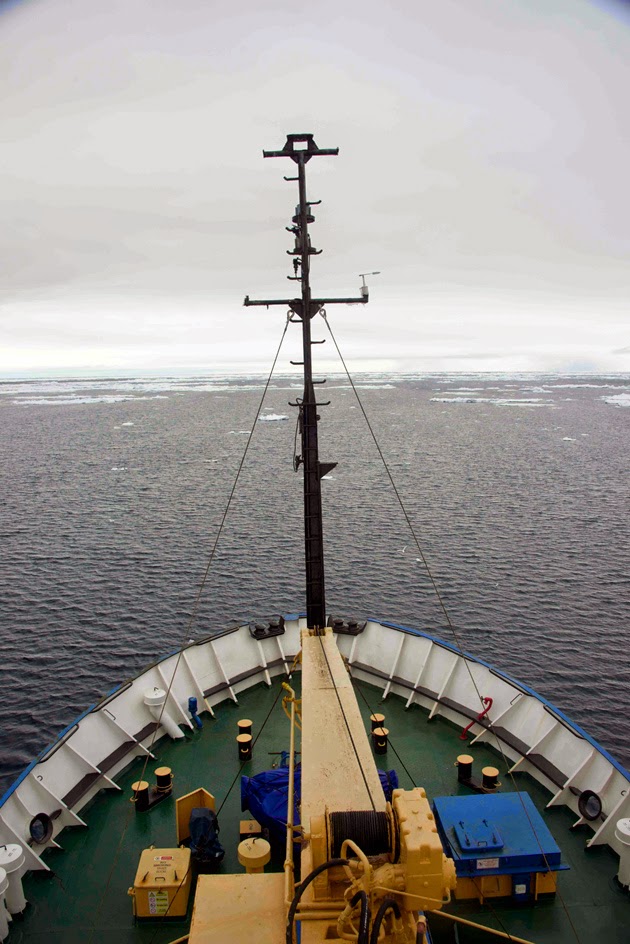Going with the floe
Punching your way through sea ice is a bit like being in a bombardment. One moment all is calm, the next silence is shattered by a crushing, grinding sound which reverberates throughout the ship. The duration of this assault on the senses can be fleeting or sustained, depending on the ice being negotiated by the vessel. The Shokalskiy is fortunately an ice-strengthened vessel but that doesn’t mean it is invincible. The ship’s captain Igor and his team have to carefully select which ice floes they negotiate while keeping an eye on what lies beyond. The rule of thumb is that only some 10-20% of ice can be seen floating above the surface. So 40 cm of visible ice means at least 160 cm is submerged. An important statistic when you’re taking an unsupported vessel deep into the pack ice, hundreds of kilometres from the nearest living soul.
 |
| Approaching sea ice |
Today had everything with dizzying highs and lows. We woke to fog but this cleared early morning to leave us with a brilliant blue sky. The contrast with the white against the horizon made a breathtaking sight. The ice was young – most probably formed this winter – and relatively open, allowing the Shokalskiy to cut a trail effortlessly. But by mid-morning it looked like we would meet thick pack ice so we decided to stop the vessel and put the team in Zodiacs to give everyone some experience with getting on and off the vessel in semi-open water. It was a good excuse to explore our local surroundings. The combination of ice sculptures, penguins, seals and whales rounded the morning off beautifully. It was extraordinary how much life there was in the immediate area of the ship. One moment, we would see Adelie penguins watching with interest, the next, a crab eater seal lying in the Sun not bothering to look up. A highlight was two dwarf minke whales – an inhabitant of typically warmer climes, including the Great Barrier Reef! Robbie managed to get a great movie of one of the whales on his iPhone and I’ve loaded this up onto YouTube.
After a late lunch we pushed on but the sea ice closed in significantly. By 1900, there was little, if any, open water between the ice. The Shokalskiy could no longer push the ice aside; in places ahead we could see the ice was buckling at points of contact, forming pressure points, heaving large segments skyward. We had no choice but to return north to a safer location and will try to probe south again later. The latest satellite images suggests northerly winds are driving thick pack ice to the northeast into our path but unfortunately heavy cloud has prevented a sea ice report being generated for Commonwealth Bay. At this rate it could be several days before we make the edge of the fast ice. Igor and his team were disappointed but we had no choice and regretfully turned around about. Our furthest south for the day was 65.430ºS 145.757ºE.
In Mawson’s Home of the Blizzard, the great man wrote that Antarctic “land lay to the south [was] beyond doubt; the problem was to reach it through the belt of ice-bound sea… Though progress can be made in dense pack, provided it is not too heavy, advance is necessarily very slow.”
Hopefully we will have more luck tomorrow.


Comments
Post a Comment